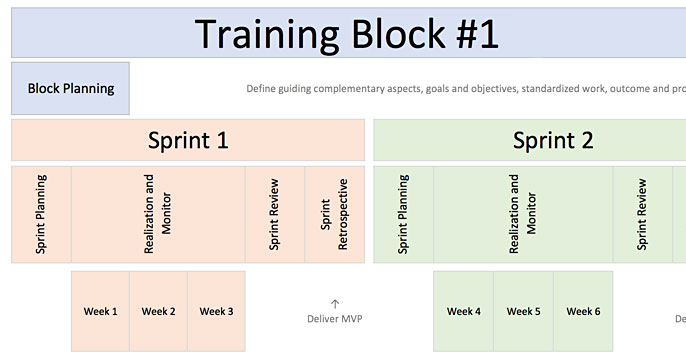More Thoughts on Agile Planning/Periodization
I would like to continue the discussion I began with Agile Planning in Sports Training screencast couple of weeks ago and provide some more random thoughts. I am also reading one great book called The Science of Successful Organizational Change that “merges” various ideas from popular leadership/productivity/change sources, risk management and Nassim Taleb works, and wrap it in interesting “No BS” approach. Author, mentions VUCA term – which is in short for Volatility, Uncertainty, Complexity and Ambiguity, which is used in business planning and estimations, and I believe we can use some of those concepts in sports since we also live in VUCA world. The whole idea of Agile Planning/Periodization is to take some of those ideas in our planning strategies.

As always nothing new under the Sun. All plans revolve (are constrained by) around (1) Goals/Objectives, (2) Athlete Characteristics and (3) Context. My objective with Agile Planning/Periodization is to put more emphasis on (3) Context, and that involves VUCA elements (although Athlete Characteristics also involve VUCA elements; e.g. responses of the athlete, etc). The point is that our plan should take into account VUCA elements, and hence needs to be more Agile in taking care of unpredictable risks, changes, etc.
In a perfectly controlled environment the “traditional” planning is of great use (we still need to use those elements, because some components/constraints of our plan are well defined and stable), so depending on predictability/stability of our constraints/components/environment we can use more traditional or agile planning. Biological realities and optimal/perfect approaches aside, we still need to take into account VUCA elements in our planning. In my opinion Agile Planning/Periodization should take those into account.
Here are some examples/random thoughts –
1. I wanted to start going to the gym again. Since I suck at writing a program for myself and I always try to “make it perfect” and cover all aspects/exercises I like doing I usually end up being paralyzed. Hence leaning more to action in action~planning continuum can help. Being more agile and starting with something (MVP – minimal viable product) and then iterate and adjust on the go. I also sometimes love to do someone else program since it is mentally easier and I don’t have to plan, but sometimes these plans are longer term (e.g. 12 weeks program) and I am not sure they provide iteration that is needed to re-adjust the plan. Especially if they are percent-based. So, I love shorter cycles (iterations) within longer phases which allows more agility and adjustments on the go, but without paralyzing me with planning, and avoiding “action bias” (no planning at all). Note: this is complementary aspect of action~plan.
2. Some personal trainers have clients that are irregular and have hectic schedules (VUCA clients?) and they struggle coaching them. I have a friend who is T&F/Sprint coach working in an environment where attendance is not so great and one never knows if athletes are coming to training. Having a rigid weekly plan in these scenarios doesn’t help at all and might make you and the athlete irritated. Biological perfectionism aside, one needs to adapt to these scenarios, and using more Agile approaches might help. For example, if one have a PT client that is unreliable with his attendance and it is hence very hard to plan Upper/Lower or any other reasonable split, one can do this:
- Session A: Full Body (cover the “Big Rocks” movements – biggest bang for the buck)
- Session B: Upper
- Session C: Lower
The plan is to start with Session A. If client is regular and on time he proceeds with Session B and then C. But, if he “breaks the chain” he restarts at Session A. This way we take his unpredictability into account and make sure we don’t follow the plan blindly and cover what can be covered (making sure these are the “Big Rocks”), while working on this attendance/accountability. Besides repeating the same session every time he breaks the cycle can make one more motivated to be regular. Or quit. PT can take this risk into account when planning and make two or three versions of Session A, while still covering “Big Rocks”.
My friend in T&F can use similar approach. Suppose we are talking about a sprinter that you never know when and if he is coming to practice. So here is example of planning:
- Session A: Sprint/Acceleration (distance varies according to longer cycle plan- long-to-short, or short-to-long progression, or both)
- Session B: Speed Endurance/Special Endurance/Plyometrics
- Session C: Strength Training
- Session D: Extensive Tempo
- Session E: Active Recovery and Modalities
The point is the restart the cycle every time the athlete breaks the chain – assuming that the break is due lack of accountability and external factors and not due too much training (biology). Dan Pfaff uses similar 3-day roll-over cycle and allows active recovery between them.
3. In team sports it is tricky to make any long term plans and nice cycles (e.g. Strength -> Power -> Endurance). Why? First off, we are dealing with 20+ athletes. Some of those athletes are starters, some are reserves and some are injured/not traveling. And these groups are dynamic, so the plan needs to take into account this fact. With longer nice cycles we risk that players might get off/on the cycle at random time. Yes, these “block training” concepts are biologically sound, especially in individual sports and sports where we can control the environment more (or environment is more stable), but with team sports and hectic competition calendar they are pretty much useless (even if they are biologically more optimal).
What happens when you have athlete getting injured and stopping during your “Hypertrophy phase” and returns to “Explosive” phase, completely missing “Max Strength” phase? How do you re-introduce him to training and the group? What happens when your older players come later to pre-season camp or training phase? How do we take this into account? Or if some of our players are sent to National Team for a week during our pre-season phase and we have no clue nor control what they are doing there? How do we prepare them for that and how do we re-introduce them to our program. Using “traditional” planning will break havoc on your mental health, since you would need to juggle 30+ plans and try to merge them to something doable. Hence, even if not biologically optimal, more Agile plans can help in these VUCA situation.
What happens if your team changes head coach/manager and so forth? In my opinion, training plans should take these elements into account and not only be based solely on biological optimums and training theory.
Make sure to check Agile Planning in Sports Training screencast if you haven’t already and please be free and share some of your thoughts.











Responses